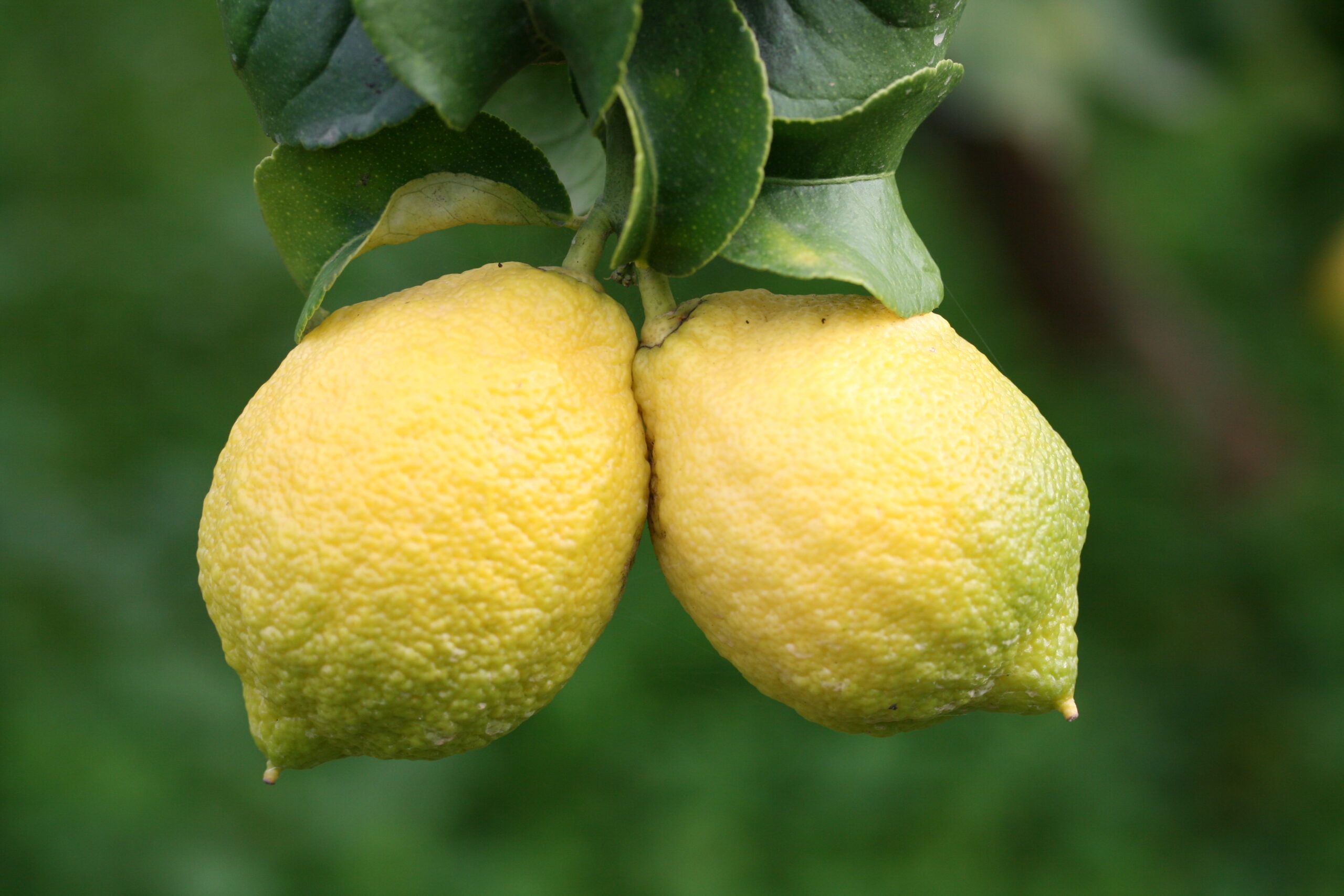With its fresh and fruity fragrance the Lemon oil reminds us of Mediterranean orchards under a blue sky and a soft breeze from the ocean. Its luminous, volatile-etheric character mobilizes our energies, relaxes and sharpens the mind, and opens the heart. The essential oil stems from cold pressed ripe Lemons with most of it present in the glands within the peel and the cuticles of the fruit. As a result of cold pressing one obtains a watery emulsion of juice, essential oil, fruit particles and water. By means of centrifugation the essential oil is then separated from the other substances.
The Lemon fruit stems from a cross breed between bitter Orange and Cedrat (Citrus medica), most probably first grown in Northern India and later in China. It is around the 10th century that the first Lemons showed up in Europe. They appeared first in Southern parts of the continent like Italy and Spain due to influence of the Arabs. Later, around the 16th century, they also came to the more Northern areas like France, Germany etc. Some people think that even during the time of the Roman Empire the Lemon tree was already cultivated in Europe.
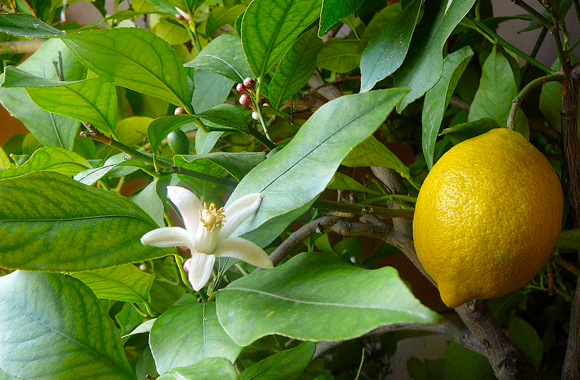
In the so-called Hesperidia group (Citrus) plenty of sunlight is received on the outer part of the fruit. Citrus fruits absorb sun light until end of January/ February in the Mediterranean regions before harvesting!! And if the peel was not so sun-spoilt and thick, the full cup of juice – it contains, would just splash out. 🙂 🙂
A Lemon tree can grow up to 10-12 m in height, but usually the trees are smaller which facilitates harvesting. The branches are thorny with shiny green leaves and white flowers. Shiny means here: not too much heat please! Give it to the fruits! And the fruits welcome even the reflection of light on the leaves because they want to drink the light and infuse their own being from “peel to core”. And the peel has its way… it is not smooth at all. It is quite hard and leathery to protect the juice – and it is wrinkled and wizened in order to increase its surface for more sun-rays to capture! And strange enough: A Lemon tree (and other Citrus trees) easily shows its beautiful white flowers and ripe fruits at the same time. And it can develop more than 200 fruits on one single tree! And what a celebration of perfumes… from the leaves, to the flowers, to the fruits, everything is fragrance in this extraordinary creation of Mother Nature!
Lemon as medicine
“In 1747, the Scottish ship’s doctor James Lind finally carried out one of the world’s first clinical studies and was able to prove the therapeutic effect of Lemon juice in the treatment of scurvy. However, it took another 40 years for the British Admiralty to accept his research results and make it a rule that all sailors protected themselves from this disease by taking an ounce of sugar with an ounce of Lemon juice every day.”
cf. “Anthrowiki”
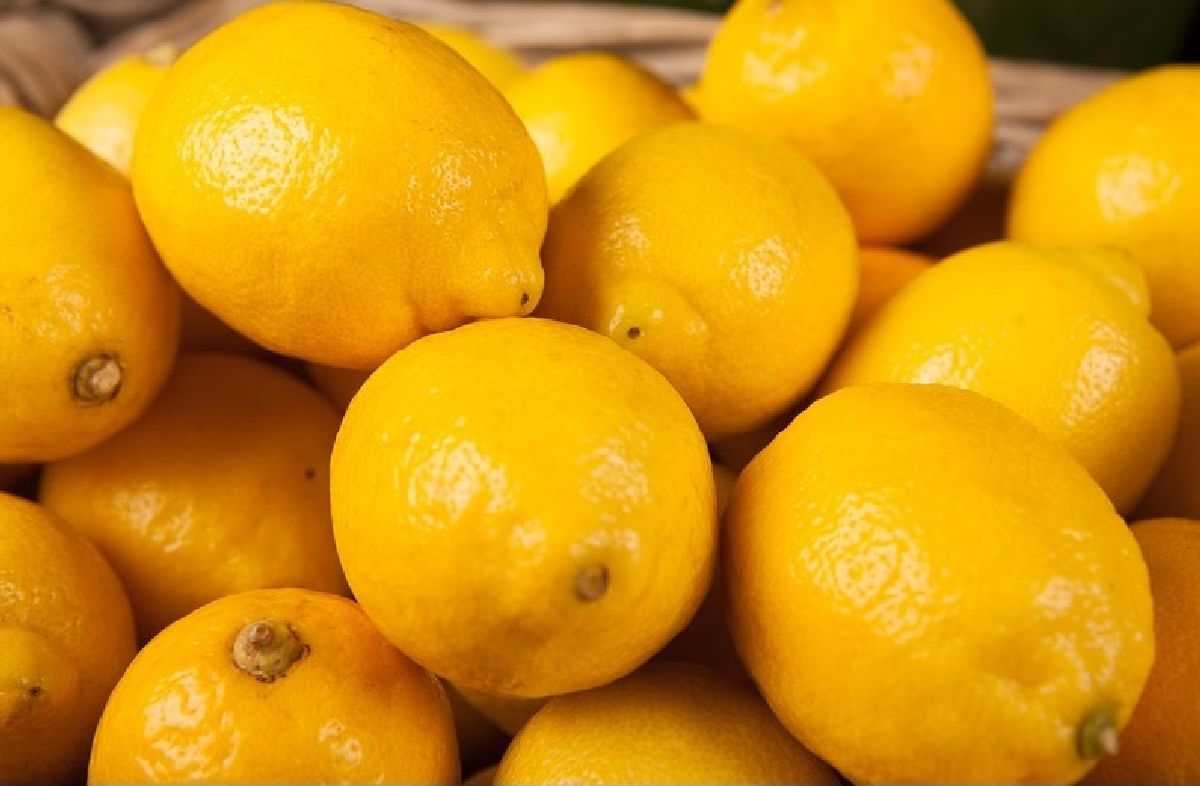
Lemon oil purifies the blood and has highly anti-bacterial properties. It is effective in cases of high blood pressure and rheumatism, but also helps against problems of cellulitis, herpes, varicose veins and greasy skin. Also problems of the respirational tract like asthma, throat infections, bronchitis, catarrh, cold and flu are connected to therapies with Lemon oil. It revitalizes sleepy, dull atmospheres and is an excellent anti-septic and aerial purifier. With its fresh-tonic and yet soothing energy, it is particularly indicated to treat insomnia, nightmares and nervous excitation.
Research has shown the powerful anti-microbial effect of Lemon oil. Decades ago already Prof. Griffon in France studied the anti-septic properties of certain essential oil blends, among which Lemon oil played a major role. And Morel and Rochaix proved long ago that the evaporated particles of Lemon oil are capable of neutralizing within 3 – 12 hours
- the meningococcus (Meningitis – blood infection) within 15 minutes
- the Ebert bacteria (Typhus) in hardly 1 hour
- the Pneumococcus (Pneumonia etc.) in 1 – 3 hours
- the Staphylococcus aureus (skin— and respiratory infections, food poisoning in 2 hours
- the hemolytic Streptococci (breaks down red blood cells – pneumonia, blood poisoning (septicemia), inflammation of the lining of the brain and spinal cord (meningitis) etc…
Cf. http://www.fourwinds10.com/siterun_data/health/holistic_alternative _medicine/news.php?q=1196612274
There is this one specific molecule group in essential oils which seems to be the number one attack force in case of cancer, and that is the compound group of “terpenes”. Terpenes are a major molecular group occurring in numerous essential oils, very strongly specifically in Citrus oils such as Lemon, Grapefruit, Bergamot, Mandarin etc. and also in the oils of Conifer trees like Silver Fir, Black Spruce, Forest Pine, Balsam Fir etc.
Prof. Hatt and his team from the University of Bochum in Germany discovered a special molecular mechanism which hampered and even stopped the growth of cancer cells through the application of terpenes such as the d-limonene which is prevalent in Lemon oil. The “triggering board” so to say for this is a smell receptor called OR1A2 which the mutated cancer cells carry on their cell membrane. “The liver can therefore ‘smell’ the molecules of essential oils” as explains Prof. Hatt. “The cancer cells react to the terpenic molecules and stop their growth”. Other studies have demonstrated the anti-tumorigenic effects of limonene against pancreatic cancer and breast cancer.
“Limonene showed antioxidant and radical scavenging activities in several model systems and cytotoxicity against MCF-7, K562, PC 1, A-549, HT-29 cell lines and HepG2 hepato-carcinoma cell lines. Bhattacharjee and Chatterjee (from India) promoted the identification of proapoptotic, anti-inflammatory, antiproliferative, antiinvasive, and potential antiangiogenic activities of limonene.” The ScientificWorld Journal see also : P. L. Crowell, A. S. Ayoubi, and Y. D. Burke, “Antitumorigenic effects of limonene and perillyl alcohol against pancreatic and breast cancer,” in Dietary Phytochemicals in Cancer Prevention and Treatment, vol. 401 of Advances in Experimental Medicine and Biology, pp. 131–136, Springer, NewYork, NY,USA, 1996.
Universities like Vanderbuilt have integrated the use of essential oils to reduce stress and provide a calmer work environment. Additionally, Rosemary, Citrus (like Lemon or Orange) and Peppermint oils can help with memory and concentration
cf. http://impactadhd.com/organize-your-life-and-family/use-essential-oils-adhd/
Valery Anne Worwood speaks in one of her books about keyboard errors which fall by over 50 % when the aroma of Lemon oil is diffused into the atmosphere of an office.
A bit about Lemon’s bio-chemistry
GC Analyes of Lemon oil show here for example
- Monoterpenes: limonene (71.81%), beta-pinène (10.72%), gamma-terpinene (9.13%), sabinene (1.76%), alpha-pinene (1.52%), myrcene (1.03%), terpinolene (0.34%), alpha-thujene (0.36%)
- Sesquiterpenes: béta-bisabolene (0.20%), (E)-alpha-bergamotene (0.14%)
- Aldehydes: neral (0.71%), geranial (1.09%)= citral
- Esters: neryl acetate (0.32%)
Two components above are major for a Citrus odour and its medicinal effect; these are the monoterpene limonene and the aldehyde citral (neral+geranial). The major component of most Citrus odour is d-limonene which can be up to 97% of the oil. It is responsible for the base sensory character of the Citrus oils. L-limonene is another terpene that possesses a totally different odor such as that found in the Pine, Peppermint and Eucalyptus oils. Fatty aldehydes also contribute to the aroma of Citrus, especially octanal and decanal. The sesquiterpene ketone (+)-nootkatone also shows a Citrus-like aroma and a bitter taste and is found in all Citrus oils. It influences strongly the fragrance of any oil in which it shows up.
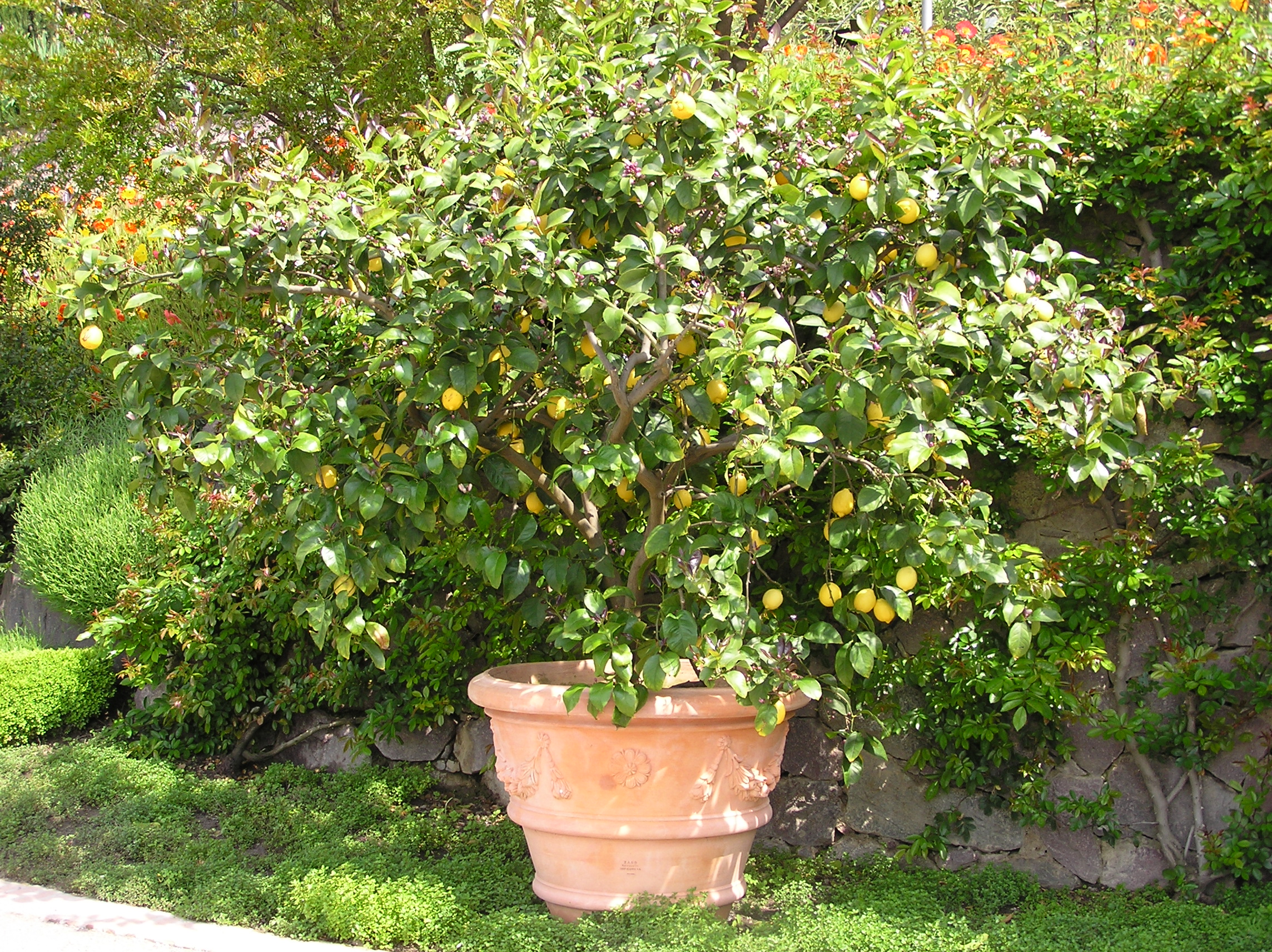
What is behind this fruit and its oil?
In the Citrus fruit “the aromatic process is no longer subtly perfuming and intoxicating as in the flower, nor oscillating, suspended as in the leaves, but refreshing, revitalizing, it makes man more conscious” writes Wilhelm Pelikan in his Books “Healing Plants: Insights through Spiritual Science”. In Ayurvedic terms, this is the influence of Prana and also Agni the omnipresent „cosmic fire“, the life force and organizer of intelligence in matter. We know today: The perfume of a plant and its essential oils are an echo of the different characters or qualities of cosmic light or heat, each fragrance representing a “colour” of the heat spectrum available on Mother Earth.
And this has to do not only with soil conditions but also with positions of plants according to latitudes on our planet. Towards the polar areas the sun’s radiation maintains a maximum of cosmic purity. Towards the tropics his radiation becomes more “earthly”. In the subtropical areas or the Mediterranean region for example there is a balance between the two. The development of essential oils in plants thus corresponds to these patterns of diversified radiation of sunlight according to seasons, stellar positions, latitudes etc..
But also the altitude at which a plant grows has a strong impact on its perfume and biochemical structure. A typical example we find in High Provence where the soft or sweet Thyme (type geraniol, linalool, thyuanol-4 etc.) grows on higher altitudes which receive more ultraviolet radiation whereas the pungent Thyme (type thymol) grows on lower altitudes which receive more infrared sunlight. Sometimes these plants just grow not more than two miles away from each other, just separated by altitude but – although from the same species – present a completely different biochemical build-up and odour profile.
In this perspective, all essential oils are the direct result of a strong ordering, balancing process which largely stems, as we have seen, from the thermic or solar influence onto the plant. Rudolf Steiner always associated the Citrus family (Rutaceae group) with the subtropical sun and its special uplifting nature for man. Citrus – and all essential oils in general – are an expression of this inherent device of Mother Nature of creating “sun-batteries” for life. They are definitely the result of a special cosmic interaction of plants with Light.
The outer yellow rind or peel of the Lemon fruit manifests this vibration of heat, or “ether of light”, represented by the essential oil – volatile and combustible – born from the thermic processes of hot and sunny climate to which the fruit is exposed throughout the year. This affinity with the sun is also represented by the yellow colour of the fruit. The carotenes (similar to chlorophyll) are the instruments for absorbing the sunlight. They become Vitamin A in human or animal physiology which is most present in the human eye, the organ of light. And the carotenes are linked to the aldehyde called citral, which strongly mark the odourous character of the Lemon rind. “With citral, we can say, light becomes perfume” say the Anthroposphs.
(cf. Wilhelm Pelikan, “Healing Plants: Insights through Spiritual Science”)
Rudolf Steiner and his successors have also often spoken of the intrinsic property of the Citrus fruits and their oils to organize life by means of their capacity to harmonize the chaotic tendencies, present in Nature (the “formative” vectors of life versus the “vegetative” ones). In this sense, Rudolf Steiner explains, the Citrus group helps infusing an element of consciousness or intelligence “capturing forcefully the cosmic energies of light and fire, making them earthly” (vegetative process) and – on the other hand – “drawing the telluric processes into a centrifugal growth” (formative process).
We can say: If plants fulfil the task of converting light into life, human beings are given the task of transforming life into consciousness, that is awareness, understanding, compassion, love… This realization shows that there is no separation between the inner and outer. The outer sun functions as a source of transformation of light into life. Our soul, the true self or Atma acts as our inner sun to transform life into cosmic awareness – and this through the activities of our nervous system. Both suns – inner and outer – communicate and nourish each other so that we can grow in understanding and evolve thanks to the union between them.
Specifically trees – but actually all plants – may justly be regarded as storehouses of this energy of light. They pick it up from the sun, transform it into life energy through the metabolic process of their photosynthetic ingenuity and in certain cases create these “living molecules of Light” which are essential oils. All living beings not only benefit from but are totally dependent on the biochemical reactions underlying this cosmic exchange.
This special “sunny” nature of the Citrus group therefore has also a lot to do with the popular use of its essential oils in Northern countries especially during winter. Aromatherapy thus helps to compensate the lack of sun light, alleviating winter depression and lethargy via the “light-spoilt”, joyful character of the Citrus oils group.
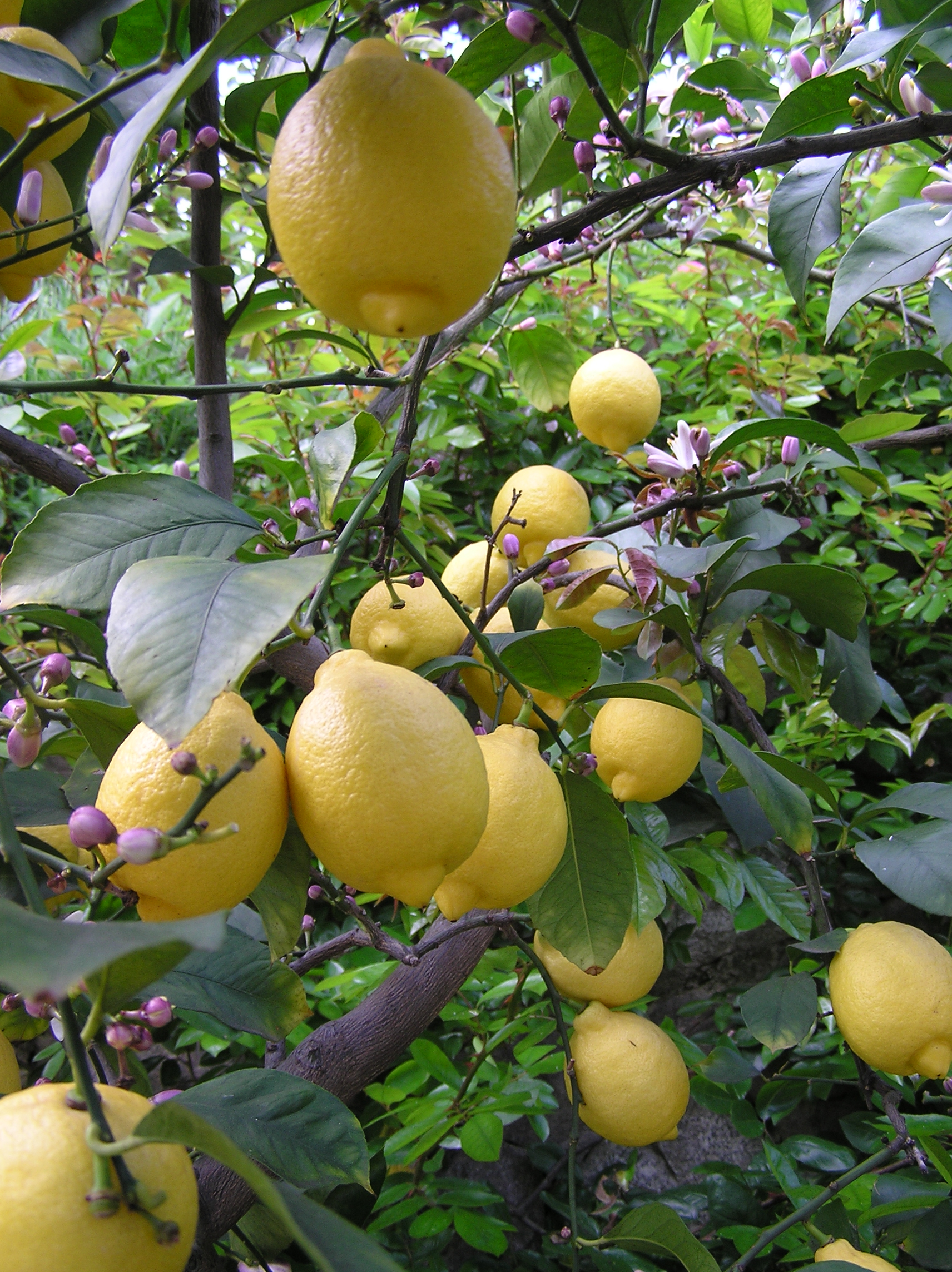
Lemon oil is good for:
- Asthenia, general fatigue, state of lassitude, loss of concentration
- Infectious and contagious diseases (intestinal, pulmonary,…), prevention of epidemics
- Digestive, hepatic and pancreatic fatigue
- Obesity, slimming, cellulite, lymphatic drainage
- Premature aging: hypertension, arteriosclerosis, capillary fragility, wrinkles
- Skin care: rashes, boils, warts, herpes, blackheads, scabs, facial seborrhoea, frostbite, freckles and brittle nails
- Couperose, phlebitis, hemorrhoids, venous stases, heavy legs
- Disinfection of the air
External use:
- In localized applications for skin ailments
- In massage in mixture with other oils to help slimming
- In diffusion for disinfection
Precautions:
- Do not expose to the sun after the application of this oil. It is very photosensitizing.
- Best to use the oil diluted for sensitive skin
- Not recommended during the first three months of pregnancy
cf. “Aromazone”
Psychological properties:
- Reinforces psychological energy and promotes the healing of diseases related to lack of energy
- Increases internal joy and optimism
- Allows more focus and re-concentrates scattered energy
- Helps mental flexibility
Some recipes:
(cf. http://www.clenama.com/Huiles-essentielles/ft-citron-BIO.htm)
Insect bites (Franchomme)
- Lemon: 2.5 ml
- Eucalyptus citriodora: 2.5 ml
- Mandarin: 2.5 ml
- Petitgrain bigarade: 2.5 ml
Apply on the sting, several times
Mosquito bite – Curative (Franchomme)
- Lemon: 1.5 g
- Bitter Orange: 1.5 g
- Mandarin: 1.75 g
- Annual Tansy: 0.25 g
Excipient in sufficient quantity for a 50 ml gel
1 application – 2 to 3 times, 15 minutes apart
Vitiligo (skin depigmentation) (D. Baudoux)
- Lemon: 3 ml
- Bergamot: 3 ml
- Clove: 1 ml
- Tea tree: 1 ml
2 drops of the mixture on the depigmented spot – 2 times a day, until significant improvement
Warts (D. Baudoux)
- Lemon: 2 ml
- Cinnamon bark: 1 ml
- Savoury: 1 ml
- Mandarin: 1 ml
1 drop of the mixture on the wart morning and evening, for 8 weeks if necessary
Further recipes:
Sinus infections/ Headaches:
we use the “Sinus Bomb”
- 2 drops of
- Lemon
- Lavender
- Peppermint
- Melaleuca oil
in a capsule and take with a glass of water. We take this as needed (depending on severity) and our sinus infections are gone in 24-48 hours. We also combine this essential oil mixture in a cup of boiling water and gently inhale with our eyes closed, this helps clear our sinuses and headache almost instantly… (Sonya M.)
Indigestion and liver disorders in children: (D. Baudoux)
- Lemon: 1 ml
- Roman chamomile: 2 ml
- Tarragon: 1 ml
- Carrot EO: 1 ml
in Hazelnut oil: 15 ml supplement
Baby: 1 drop of the mixture in 1/2 teaspoon of honey (well mixed) – 2 to 3 times a day, as needed
Child: 2 to 3 drops of the mixture in 1/2 teaspoon of honey (well mixed) or on 1/4 of a lump of cane sugar to suck – 2 to 3 times a day, as needed
Cellulite (hydro lipidic retention): (Franchomme)
Cutaneous way with circulatory activating and desclerosing aim:
- Lemon: 2 ml
- Eucalyptus citriodoura: 1.5 ml
- Cedar atlas: 2 ml
- Cypress: 2 ml
- Niaouli: 1 ml
in Hazelnut oil : 100 ml
2 to 3 applications per day in situ, for 30 days
Conclusion:
Lemon is a wonderful gift of the universal intelligence of Nature. It is hard to see our lives today without such an amazing medicinal plant fruit – and now, since a while already, without such a powerful essential oil. As a cooler of hot emotions, a dispeller of gloomy feelings, and at the same time an anti-microbial agent of luminous radiance, Lemon oil in modern Aromatherapy has become a major helper for so many daily and even chronic health problems of man. Indeed, we can only be grateful for this beautiful capturer of Cosmic light to be able to pierce the frozen armour of our stress and fatigue and to lift us up to where our soul yearns to spread its wings.
